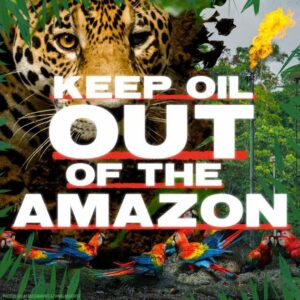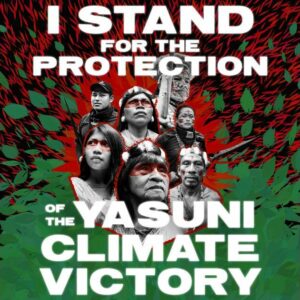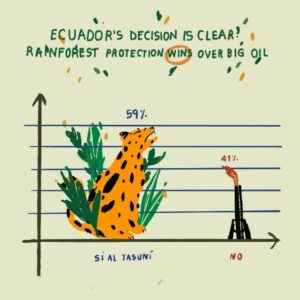Community-led Education
Strengthens
Indigenous Peoples’ Roots
in the Amazon
A proposal to recover culture, strengthen
territorial defense, and reclaim the importance
of spirituality among Amazonian nations
by: Isabel Alarcón
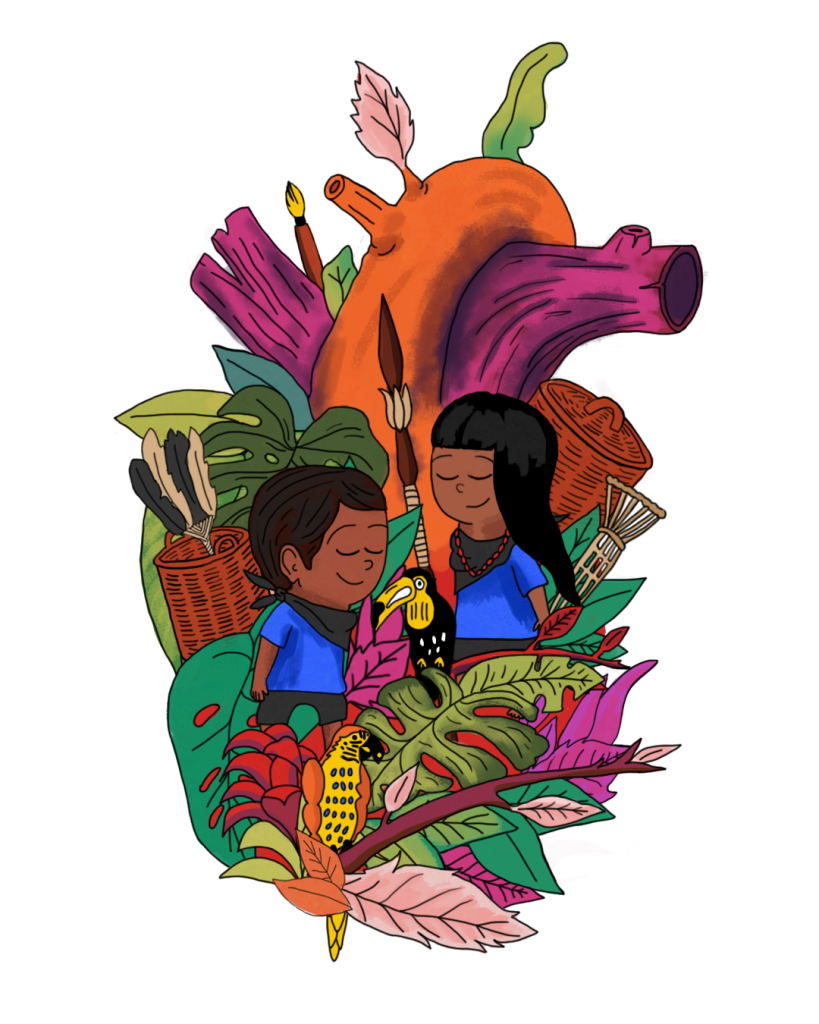
Baskets, shigras, spears, and bracelets are Lorenzo Simbaña’s main allies when teaching math, history, science, and language. In a classroom located in the Waorani community of Daipade, surrounded by the Ecuadorian Amazon rainforest, Lorenzo uses a variety of Waorani crafts and traditional elements to teach his students the importance of learning without abandoning their roots.
Each wall in the classroom has a different theme. In the “math corner,” there are a variety of pieces of balsa wood in various shapes: square, round, and rectangular. There are also pots, colored construction paper, and seeds collected from the forest. To one side is the “crafts corner,” where feathers, crowns, fans, and necklaces hang on the wall. “All of these ornaments were made by students between the ages of 8 and 12,” Simbaña says proudly.
Through crafts, Lorenzo is able to put into practice concepts that students previously had to memorize. By making a basket, for example, they practice math, as they learn to calculate the distance and time it takes to collect fiber in the forest. They also need to add to calculate the number of sticks they must collect. And they need to practice division, as they have to cut the fiber into pieces until they get the ideal shape.

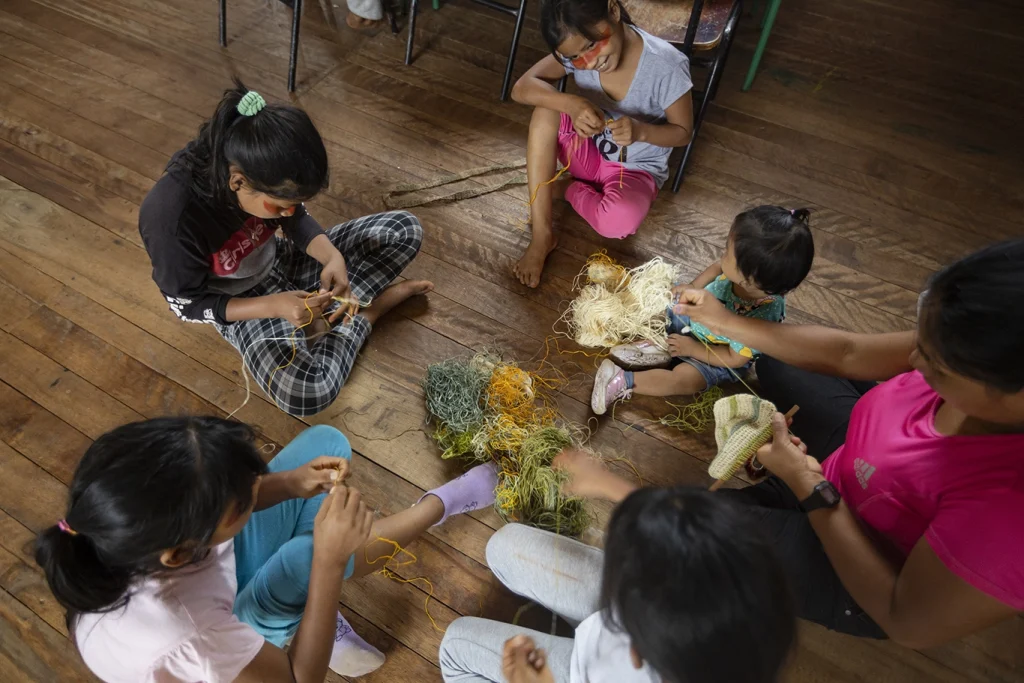
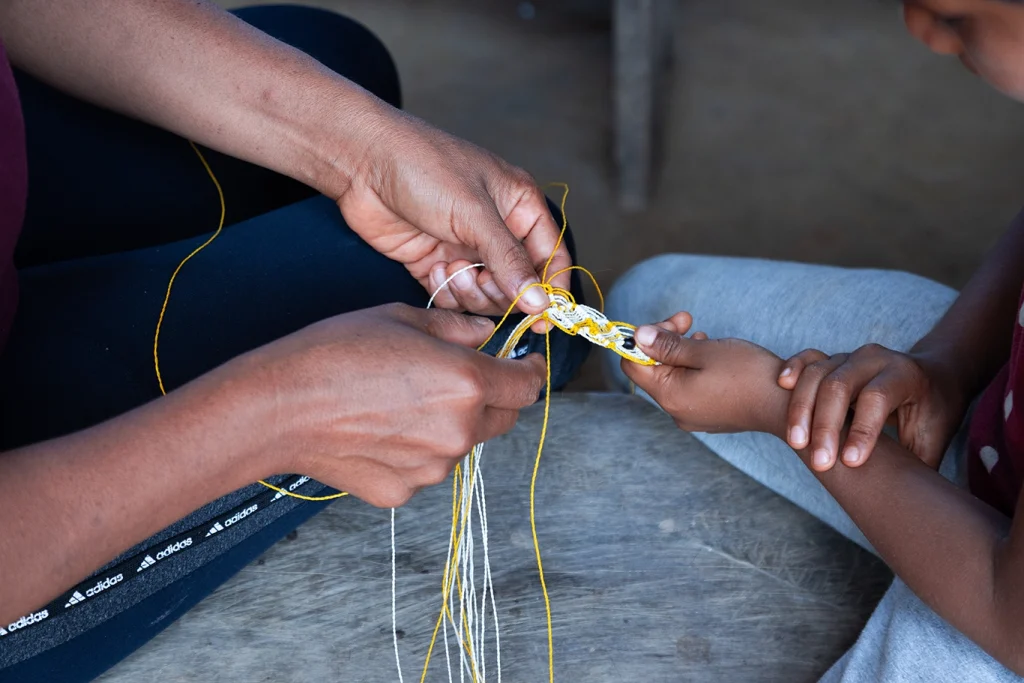
This network aims for cultural revitalization, which includes recovering practices that had been lost and incorporating Western knowledge into the curriculum
The same basket later serves as a way to practice language. Once the basket is finished, the teacher asks students to explain how they made it, what materials they used, the history of basket-making, and what baskets can be used for. Throughout the class – and without any pressure from Simbaña – geometry, natural sciences, and social sciences are introduced, always connecting students to their culture.
These activities are part of the path toward community-led education that the Waorani communities of Pastaza have been implementing in their territory since 2019. The dynamic no longer consists of sitting behind a desk for eight hours a day, reading what the teacher writes on the blackboard, repeating theory hundreds of times, or listening to stories with no connection to students’ language or their way of life.
“A new curriculum is being built,” says Patricia Peñaherrera, “with an active methodology that is very different from what we’re used to seeing in primary schools, and it’s bearing fruit.” Peñaherrera is a facilitator with Amazon Frontlines and the Ceibo Alliance, organizations that support Amazonian communities in this community-led education program.
This network aims for cultural revitalization, which includes recovering practices that had been lost and incorporating Western knowledge into the curriculum. This is the opposite of customary Spanish-language education, which is far removed from the learning methods of the Amazonian peoples, which are based on listening, observation, and action.
The program is already being implemented in six Waorani communities and has expanded to the territories of the A’i Cofán and Siekopaai nations. Although each has its particularities, the efforts of the three nations intertwine to form a diverse network with a common goal. Through community-led education, they are recovering the stories of their elders, strengthening territorial defense, and honoring the importance of spirituality.
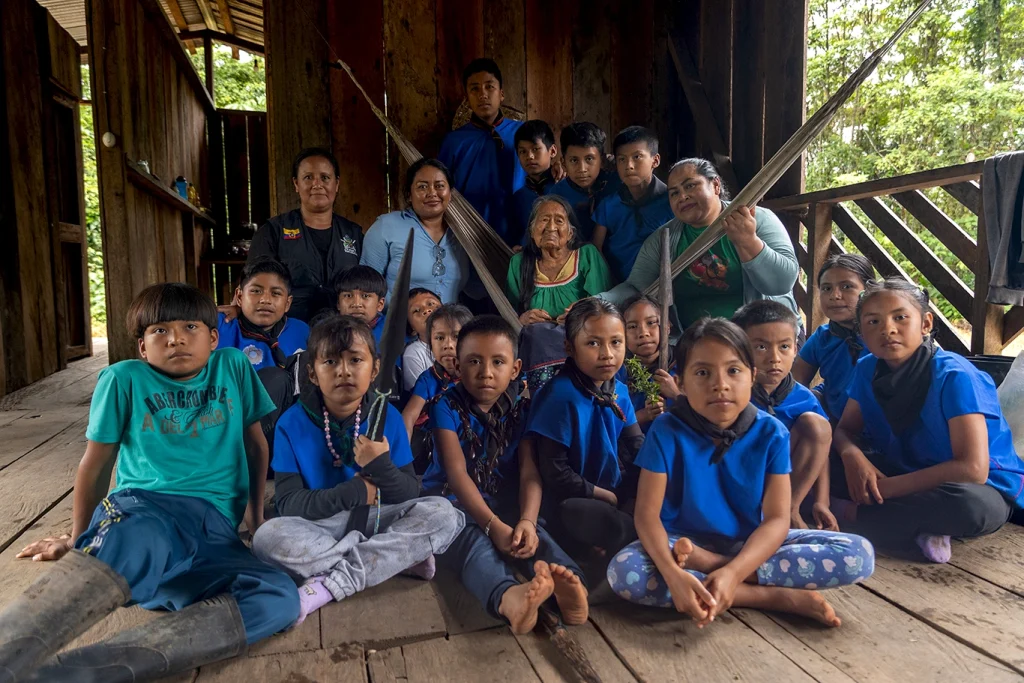
A methodology of active education
“Education is like a large tree that, thanks to its strong roots, grows branches and flourishes,” says Gaba Guiquita, speaking from the doorway of the classroom where community-led education is imparted in the Waorani community of Kenaweno. Here, as at the Daipade school, children ages 5 to 11 are strengthening their roots.
Watching the students studying in class, Gaba recalls the program’s origins. In 2019, faced with the weakening of the Wao Tededo language and the disconnection of the youngest children from cultural practices and knowledge, the community began a process of reflection. This led to an assessment to evaluate what was being taught and learned in the classroom.
One of the main characteristics of this assessment was the participation of all sectors of the population: seniors, authorities, parents, teachers, youth, and children. “We went from community to community, and then we held a large assembly where we discussed and debated the program. We held a vote and won. That’s how I began working with Patricia and Nemo Nenquimo,” says Gaba, who was the Education Leader of the Waorani Organization of Pastaza (OWAP) until 2024.
The Community Education Project was developed over two years, during which the Waorani evaluated the effectiveness of their own pedagogy. They wanted to see what would happen if they let the children leave the classroom and take advantage of the resources around them to learn. This experimentation resulted in new elements of the program, allowing the educators to delve deeper into the pedagogy of community-led education by including autonomous knowledge.
“Education is like a large tree that, thanks to its strong roots, grows branches and flourishes”
– Gaba Guiquita, facilitator of Indigenous education in Kanaweno



“Children like to learn while sitting on the floor, working in groups, or with teaching materials. When they’re put in front of a blackboard, they get bored”
– Vilma Guiquita, facilitator of Indigenous education in Kanaweno
“Children like to learn while sitting on the floor, working in groups, or with teaching materials. When they’re put in front of a blackboard, they get bored,” says Vilma Guiquita, the volunteer teacher who imparts community-led education in Kenaweno. Her classes are held in Wao Tededo, and they begin with activities and games to engage the children.
One day a week, she also invites an elder or “Pikenani” to talk to students about ancestral medicine, to show them how to light a fire, or to teach them how to recognize different animals in the forest.
“If the Pikes die, their knowledge goes with them. Therefore, the students must learn from them how to make spears for war, how to create ornaments, how to hunt, how to recognize different calls, or how to make a hammock. That’s community-led education,” Gaba emphasizes.
Similar activities are carried out at the Daipade school. Lorenzo, the teacher, says that every Thursday, a parent suggests an activity, such as making a spear or a basket, and all the children bring their materials. To learn about natural science, they visit gardens, cultivate plants, and monitor their growth. This way, they put into practice what they read in science textbooks.
Lorenzo always tells them that education was very different when he was young. “The teachers were very strict. Once, as a punishment, they made me carry a large bench that was made for three people, and I had to run around the yard while another classmate followed behind with a whip,” he says.
Randi Enqueri, the current leader of Owap’s community-led education system, agrees that during his childhood, education was more rigid. Students had no contact with the forest during school hours. “It was very difficult. The teachers were from cities; sometimes they would pull my ear to punish me and mistreat me. Now we want teachers to be well-educated in the culture,” he says.
Randi is studying educational pedagogy. His greatest wish is for children to be free and to know their community’s stories, tales, and songs, so they never forget their language.

Education to Defend Territory
Gaba emphasizes another focal point of the project: the link between learning and the protection of the forest. “Those who defend the territory will have good trees and will live forever like our grandparents. Some young people think about moving away or cutting down trees, but community-led education teaches something else: if you defend the forest, no government can come to take away the territory,” he says.
In the northern Amazon, the A’i Cofán nation is clear about this concept. Through community-led education, they are not only recovering ancestral knowledge and cultural practices, but also training children to learn about the importance of defending their home.
The pilot program for community-led education is being implemented in the community of Sinangoe. There, a training program for future Indigenous guards, or ‘Chipiri Kuirasundekhu,’ has been formed. 43 children between the ages of 7 and 13, who seek to be the future defenders of the Amazon, are part of this group.
“The children told us they want to be guards, like the adults,” says Alexandra Narváez. “We had a meeting with parents, and we explained the idea to them. They were happy because there are children who don’t know about medicine, sacred sites, or history, and we want our children to learn those things.” Alexandra is the first woman to join the Sinangoe Indigenous Guard. This group has been recognized for its fight against mining. In 2018, they successfully reversed mining concessions that were allowing operations near the Aguarico River.
In the northern Amazon, the A’i Cofán nation is clear about this concept. Through community-led education, they are not only recovering ancestral knowledge and cultural practices, but also training children to learn about the importance of defending their home
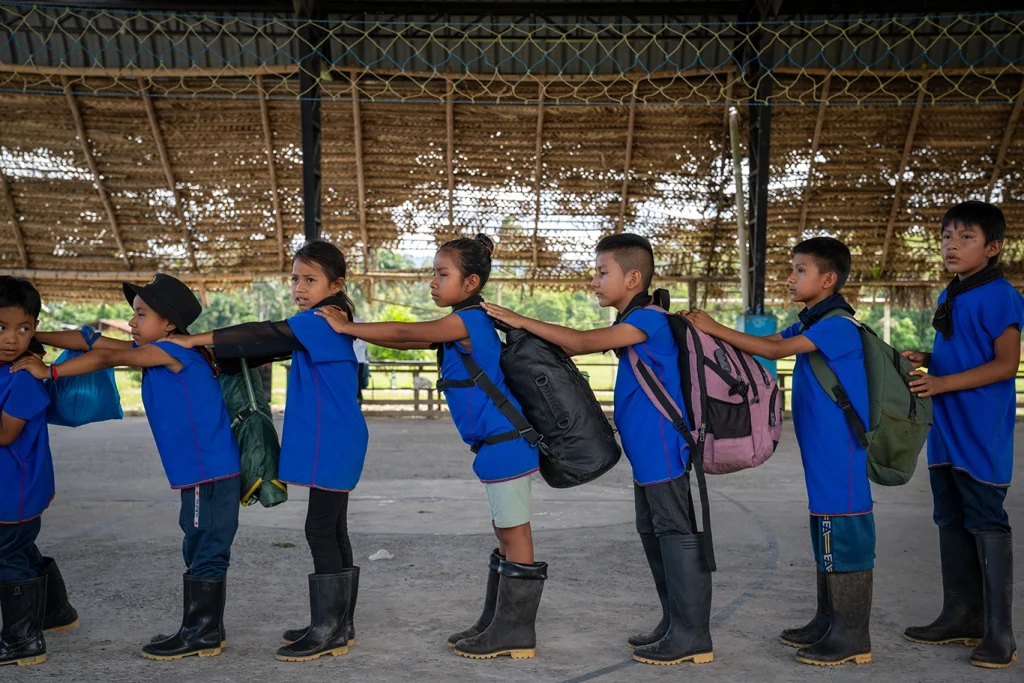


“I want to learn to walk far, knowing many things, like the guards do,” says 14-year-old Jorge Luis Chimbiligua Quenama, with excitement. Along with his siblings, ages 6 and 12, Jorge Luis attended the second meeting of the guard training group, which took place in March 2025. The day began in the community meeting space of Sinangoe, where girls and boys, dressed in their blue and black uniforms, lined up to listen attentively to the adult guards.
“Respect, punctuality, and solidarity,” Alexandra repeated, hoping the students would never forget these values. After introducing themselves, children and adults set off on their adventure, first by canoe for about 20 minutes, and then traversing slopes and muddy paths until they reached their goal: Segueyo. The children themselves were the ones who suggested going to this place, Alexandra says. At the previous meeting, their grandparents had told them that invisible beings, who guard the territory, live in Segueyo.
Under rainfall, they set up their tents in the middle of the forest and began the experience of learning firsthand what it means to be a guardian of the territory. “Some of you are tired or have stomach aches. Don’t give up. We want to learn little by little. I encourage us all to keep going,” said 12-year-old Jordan Andy, in front of the campfire.
Just then, the elders began to tell their stories in Ainge, the Ai Cofán language. The tales of what the forest was like in the past made the children forget about the cold and focus on listening to their elders. Alexandra also reminded them of the reasons for fighting: “The territory where Lago Agrio is located used to be our central place. The oil company arrived and killed our elders. They invaded and drove us from our territory. We are training so that they can’t take away the space we have left.”
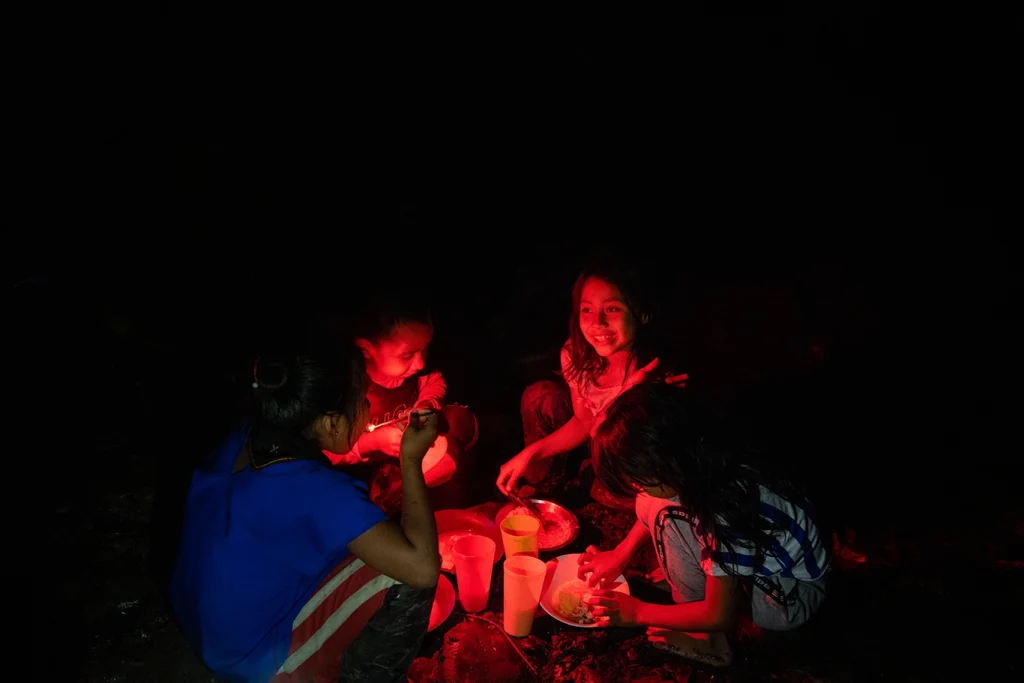
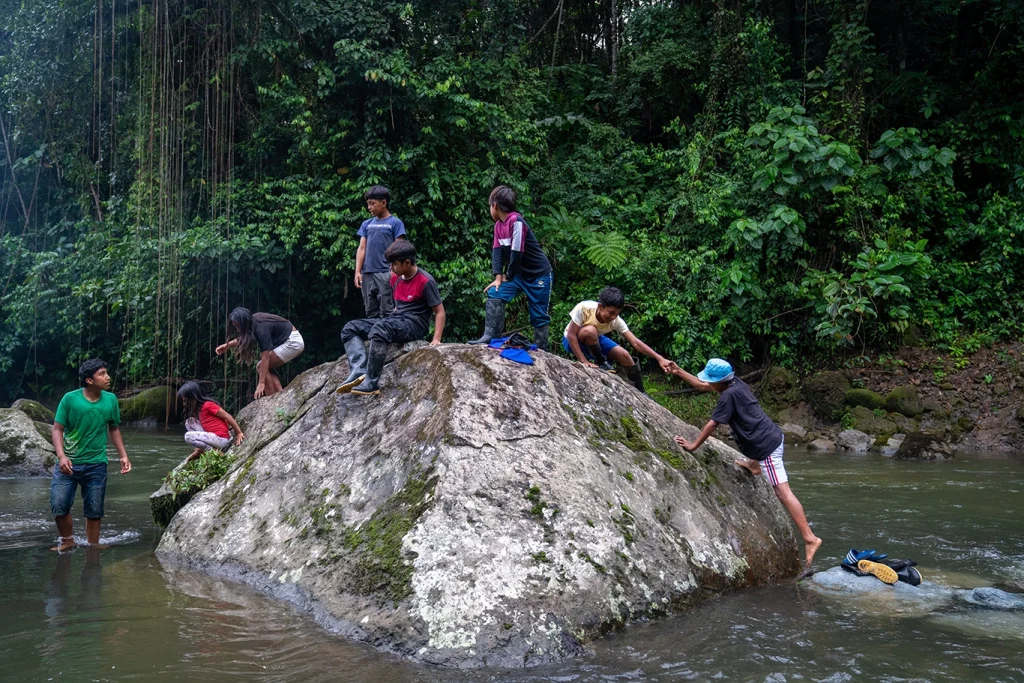
“This is what community-led education is all about. Through real-life experiences, not just in workshops, we are teaching them medicine, stories, and how to revive practices such as making shigras, fishing nets, canoes, and straw brooms”
– Alexandra Narváez, Indigenous land defender from Sinangoe
The next day, the learning continued. The children separated into groups and explored the forest in search of medicinal plants. Some easily recognized the indications and uses of each species, while others had never seen them before. With the help of the elders, children learned to identify the use of each plant: some are for stomach pain, others for the flu, and some for sores on the mouth.
“This is what community-led education is all about. Through real-life experiences, not just in workshops, we are teaching them medicine, stories, and how to revive practices such as making shigras, fishing nets, canoes, and straw brooms,” says Alexandra. Physical training to defend the territory is woven into learning other manual skills. As of this year, these skills and training are part of the curriculum taught to all primary school students in Sinangoe.
Despite the positive results that have come with the implementation of the program, the students still face an obstacle that limits their learning. In 2019, the school building in Sinangoe collapsed due to river erosion, and so far, the Ministry has not addressed the problem. The community has adapted by using another temporary space, but it is not an appropriate environment for the children to learn.

Spirituality and Culture in the Classroom
In Siekopaai territory, education is closely linked to spirituality. The Siekopaai Nation is located in the province of Sucumbíos, in the northern Ecuadorian Amazon, and pilot programs are being implemented in the communities of Remolino and San Pablo.
As with the efforts of the other two Indigenous nations discussed here, the process began with an assessment. “We thought we were familiar with our entire culture and gastronomy, but that wasn’t the case. Everything was disconnected,” says Wilfrido Lucitande. Wilfrido is 40 years old and one of the volunteer teachers training in community-led education.
Unlike the experience of the Waorani and Ai Cofán nations, the Siekopaai did not focus on cultural practices, but rather embarked on a process of reflection about who the Siekopaai are as a people, how they think, what they believe, how they live, and, above all, what is the nature of their spiritual worlds. Through this exercise, which lasted more than a year, a proposal for community-led education was prepared that incorporated cultural elements and the influence of this spiritual world.
Every week, Wilfrido comes to the school where this pedagogy is taught in the San Pablo community, on the banks of the Aguarico River. There, he helps a teacher called Elina to facilitate activities with children ages 5 to 7. The classroom is a kind of tunnel built with colorful hoops, imitating the shape of a snake. Upon entering, Wilfrido stands out in the middle of the room. The children squeeze through the hoops and cross the classroom space until they reach the water corner. They put their hands in a tub and play until the teacher asks them to go outside and collect leaves. They return with sticks, stones, flowers, and banana and boya leaves.
Wilfrido explains to them in Paicoca, the community’s language, that the next activity is to form snakes with the plants that the children have collected. “They have to get to know these animals because later we’re going to start talking about the relationship between snakes and shamans. We’re preparing them so they’ll understand later what we’re talking about in our stories and tales, and how it all relates to our struggle for territory,” explains the teacher.
Some tables have musical instruments and others have paintbrushes, paints, clay, and modeling clay. There are also soft and rough fabrics that imitate reptile skin. The class activities revolve not only around snakes, but also around water in general. Wilmer Piaguaje, Educational leader of the Siekopaai Nation, explains that this is precisely an example of how spirituality is present throughout the sessions. “We start from the Siekopaai worldview, which holds that there are nine worlds,” he explains. Water is one of these worlds. Each month, they delve deeper into a different world.
“Western education teaches us that water is H2O, that it contains fish and oxygen, and that’s about it,” says Wilmer. “But based on our understanding, it’s important to know that there are spiritual beings living there.”
“Western education teaches us that water is H2O, that it contains fish and oxygen, and that’s about it… But based on our understanding, it’s important to know that there are spiritual beings living there”
– Wilmer Piaguaje, Educational leader of the Siekopaai Nation



“Gastronomy tends to strengthen culture. We don’t want to lose the food our ancestors made, and the goal is for us to maintain these recipes”
– Elkin Piyaguaje, facilitator in Siekopaai Indigenous education
Gastronomy is another element in the classroom curriculum. Every Wednesday, children between the ages of 4 and 12 gather in the Maloca, a communal space. The Maloca is shaped like a traditional house of the Siekopaai Nation, with a roof of palm leaves.
Inside the Maloca, the elders told students about the origins of their recipes. At one of these gatherings, Grandmother Maruja Payaguaje explained the story behind unkuisi, a fruit harvested in Siekopaai territory. The children listened attentively to the story. Afterward, they peeled the unkuisi, pounded it to remove the seeds, blended it, and finally placed it in buckets. Another group peeled chonta, and the more experienced students prepared fish.
“Today is my favorite day,” said eight-year-old Analia Payaguaje, while handling a knife with the skill of a professional. While the food was cooking, Elkin Piyaguaje, a Siekopaai education facilitator at the Ceibo Alliance, recapped what the students had learned.
“Gastronomy tends to strengthen culture. We don’t want to lose the food our ancestors made, and the goal is for us to maintain these recipes,” says Elkin, who is 24 years old. At the end of the activity, everyone sat around banana leaves and shared the food they had prepared.
Elkin explains that one of the Siekopaai Nation’s plans is to compile stories surrounding food into a physical repository so that teachers can work with these materials in the future.
Although each Indigenous nation has determined its own pathways and goals, they all agree on the desire to continue expanding community-led education in their territories. The next step is to present each nation’s process to the Ministry of Education for official approval. Meanwhile, in each community, as Gaba said, people are already reaping the rewards of having developed stronger roots.
Credits:
Text: Isabel Alarcón / Edition: Luisana Aguilar, Allison Keeley
Photos: Daris Payaguaje, Mateo Barriga, Michelle Gachet
Morella Mendua, Nicolás Kingman and Nixon Andy
Illustration and design: Mónica Aranda
Interview Translated from Spanish: Christopher Curran

